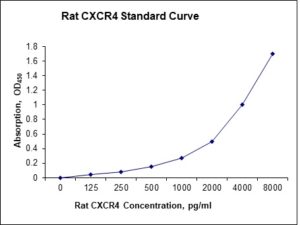Nori Rat CXCR4 ELISA Kit
$461.00 – $832.00
This ELISA kit is for quantification of CXCR4 in rat. This is a quick ELISA assay that reduces time to 50% compared to the conventional method, and the entire assay only takes 3 hours. This assay employs the quantitative sandwich enzyme immunoassay technique and uses biotin-streptavidin chemistry to improve the performance of the assays. An antibody specific for CXCR4 has been pre-coated onto a microplate. Standards and samples are pipetted into the wells and any CXCR4 present is bound by the immobilized antibody. After washing away any unbound substances, a detection antibody specific for CXCR4 is added to the wells. Following wash to remove any unbound antibody reagent, a detection reagent is added. After intensive wash a substrate solution is added to the wells and color develops in proportion to the amount of CXCR4 bound in the initial step. The color development is stopped, and the intensity of the color is measured.
Alternative names for CXCR4: C-X-C chemokine receptor type 4 (CXCR-4), fusin or CD184
This product is for laboratory research use only not for diagnostic and therapeutic purposes or any other purposes.
- Description
- How Elisa Works
- Product Citation (0)
- Reviews (0)
Description
Nori Rat CXCR4 ELISA Kit Summary
Alternative names for CXCR4: C-X-C chemokine receptor type 4 (CXCR-4), fusin or CD184
| Assay Type | Solid Phase Sandwich ELISA |
| Format | 96-well Microplate or 96-Well Strip Microplate |
| Method of Detection | Colorimetric |
| Number of Targets Detected | 1 |
| Target Antigen Accession Number | O08565 |
| Assay Length | 3 hours |
| Quantitative/Semiquantitative | Quantitative |
| Sample Type | Plasma, Serum, Cell Culture, Urine, Cell/Tissue Lysates, Synovial Fluid, BAL, |
| Recommended Sample Dilution (Plasma/Serum) | No dilution for sample <ULOQ; sufficient dilution for samples >ULOQ |
| Sensitivity | 25 pg/mL |
| Detection Range | 125-8000 pg/mL |
| Specificity | Natural and recombinant rat CXCR4 |
| Cross-Reactivity | < 0.5% cross-reactivity observed with available related molecules, < 50% cross-species reactivity observed with species tested. |
| Interference | No significant interference observed with available related molecules |
| Storage/Stability | 4 ºC for up to 6 months |
| Usage | For Laboratory Research Use Only. Not for diagnostic or therapeutic use. |
| Additional Notes | The kit allows for use in multiple experiments. |
Standard Curve
Kit Components
1. Pre-coated 96-well Microplate
2. Biotinylated Detection Antibody
3. Streptavidin-HRP Conjugate
4. Lyophilized Standards
5. TMB One-Step Substrate
6. Stop Solution
7. 20 x PBS
8. Assay Buffer
Other Materials Required but not Provided:
1. Microplate Reader capable of measuring absorption at 450 nm
2. Log-log graph paper or computer and software for ELISA data analysis
3. Precision pipettes (1-1000 µl)
4. Multi-channel pipettes (300 µl)
5. Distilled or deionized water
Protocol Outline
1. Prepare all reagents, samples and standards as instructed in the datasheet.
2. Add 100 µl of Standard or samples to each well and incubate 1 h at RT.
3. Add 100 µl of Working Detection Antibody to each well and incubate 1 h at RT.
4. Add 100 µl of Working Streptavidin-HRP to each well and incubate 20 min at RT.
5. Add 100 µl of Substrate to each well and incubate 5-30 min at RT.
6. Add 50 µl of Stop Solution to each well and read at 450 nm immediately.
Background:
C-X-C chemokine receptor type 4 (CXCR-4) also known as fusin or CD184 is a protein that is encoded by the CXCR4 gene.[1] CXCR-4 is an alpha-chemokine receptor specific for stromal-derived-factor-1 (SDF-1 also called CXCL12), a molecule endowed with potent chemotactic activity for lymphocytes.[2] HIV uses CXCR4 to infect CD4+ T cells. It is unclear as to whether the emergence of CXCR4-using HIV is a consequence or a cause of immunodeficiency. CXCR4 is upregulated during the implantation window in natural and hormone replacement therapy cycles in the endometrium, producing, in presence of a Rat blastocyst, a surface polarization of the CXCR4 receptors suggesting that this receptor is implicated in the adhesion phase of Rat implantation. CXCR4’s ligand SDF-1 is known to be important in hematopoietic stem cell homing to the bone marrow and in hematopoietic stem cell quiescence. It has been also shown that CXCR4 signaling regulates the expression of CD20 on B cells. Until recently, SDF-1 and CXCR4 were believed to be a relatively monogamous ligand-receptor pair. Recent evidence demonstrates ubiquitin is also a natural ligand of CXCR4.[3] Ubiquitin is best known for its intracellular role in targeting ubiquitylated proteins for degradation via the ubiquitin proteasome system. Evidence in numerous animal models suggests ubiquitin is anti-inflammatory immune modulator and endogenous opponent of proinflammatory damage associated molecular pattern molecules. MIF is an additional ligand of CXCR4.[4] CXCR4 is present in newly generated neurons during embryogenesis and adult life where it plays a role in neuronal guidance. The levels of the receptor decrease as neurons mature. CXCR4 mutant mice have aberrant neuronal distribution. This has been implicated in disorders such as epilepsy.[5] CXCR4 dimerization is dynamic and increases with concentration.[6]
References
- Moriuchi M, et al. (1997). Journal of Immunology. 159 (9): 4322–9.
- Kryczek I, et al. (2007). American J Physiol. Cell Physiol. 292 (3): C987-95.
- Saini V, et al. (2010). The Journal of Biological Chemistry. 285 (20): 15566–76.
- Bernhagen J, et al. (2007). Nature Medicine. 13 (5): 587–96.
- Bagri A, et al. (2002). Development. 129 (18): 4249–60.
- Işbilir A, et al. (2020). Proc Natl Acad Sci USA. 117 (46): 29144–29154.




























Reviews
There are no reviews yet.